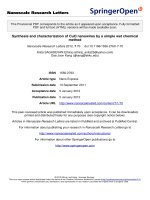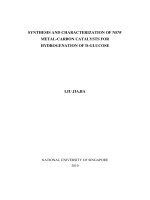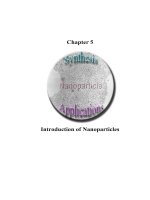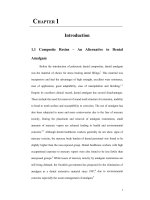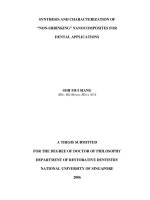Synthesis and characterization of silver nanoplates by a seed mediated method
Bạn đang xem bản rút gọn của tài liệu. Xem và tải ngay bản đầy đủ của tài liệu tại đây (2.14 MB, 8 trang )
Communications in Physics, Vol. 29, No. 3 (2019), pp. 285-292
DOI:10.15625/0868-3166/29/3/13763
SYNTHESIS AND CHARACTERIZATION OF SILVER NANOPLATES BY A
SEED-MEDIATED METHOD
MAI NGOC TUAN ANH1,2,† DO THANH SINH1 , NGO VO KE THANH1 ,
NGUYEN THI THU TRANG3 , NGUYEN THI PHUONG PHONG2 AND NGUYEN DAI HAI4
1 Nanotechnology
Lab, Research Laboratories of Saigon Hi-Tech Park,
Lot I3 , N2 Street, District 9, Ho Chi Minh City, Vietnam
2 Falculty of Chemistry, Univesity of Science Vietnam National University Ho Chi Minh City,
227 Nguyen Van Cu Street, District 5, Ho Chi Minh City, Vietnam
3 Falculty of Material Technology, Univesity of Technology National University Ho Chi Minh City,
268 Ly Thuong Kiet Street, District 10, Ho Chi Minh City, Vietnam
4 Institute of Applied Materials Science, Vietnam Academy of Science and Technology,
01 Mac Dinh Chi Street, District 1, Ho Chi Minh City, Vietnam
† E-mail:
Received 17 April 2019
Accepted for publication 22 August 2019
Published 3 September 2019
Abstract. Silver nanoplates (SNPs) having different size were synthesized by a seed-mediated
method. The seeds-silver nanoparticles with 4–6 nm diameters were synthesized first by reducing
silver nitrate with sodium borohydride in the present of Trisodium Citrate and Hydrogen peroxide. Then these seeds were developed by continue reducing Ag+ ions with various amount of
L-Ascorbic acid to form SNPs. Our analysis showed that the concentration of L-Ascorbic acid,
a secondary reducing agent, played an important role to form SNPs. In addition, the size and
in-plane dipole plasmon resonance wavelength of silver nanoplates were increased when the concentration of added silver nitrate increased. The characterization of SNPs were studied by UV-Vis,
FE-SEM, EDS and TEM methods.
Keywords: silver nanoplate; seed-mediated; plasmon resonance; L-Ascorbic acid.
Classification numbers: 61.46.-w, 62.23.Kn.
c 2019 Vietnam Academy of Science and Technology
286
SYNTHESIS AND CHARACTERIZATION OF SILVER NANOPLATES BY A SEED-MEDIATED METHOD
I. INTRODUCTION
Metallic
(gold
and
silver) are [6].
interesting
scientistsalso
around the
citrate innanomaterials
the formation of
silver
nanoparticles
Jason M.objects
Haber of
andmany
his colleagues
studiedofthe
formation
silver nanoparticles
with as
thisthe
method
butplasmon
have not resonance
yet investigated
world because
their
specialofoptical
properties such
surface
(SPR) [1,2]
the effect
of Ascorbic
Acidscattering
on the size(SERS)
of the nanoplate
or the Raman
enhances
surface
[3]. The[7].
optical properties of silver nanopartiour shape
research,
are made
by ananoparticles
seed-mediated have
method
according
to absorpcles depend onIntheir
andsilver
sizenanoplates
[1,2]. Spherical
silver
only
one SPR
Jason
M.
Haber
with
some
modifications.
We
investigated
the
effect
of
L-Ascorbic
Acid
tion at 390 - 410 nm whereas silver nanoplates have three SPR absorptions due to their anisotropic
on including
the formation
of silver nanoplates
and investigated
their surface
properties,
out-of-plane
quadrupole
SPR at 330-350
nm, plasmonics.
in-plane quadrupole SPR at
400-450 nm and in-plane dipole SPR from 450 to 900 nm [1–3], this special optical property
EXPERIMENTS
makes theII.silver
nanoplates red, orange, blue, green while spherical nano silver are yellow.
Silver nanoplates can be synthesized by single step reduction of Ag+ ions [4] or through 2
Silver
nanoplates
(SNPs) were
synthesized
setps: developed
synthesized into
smalla spherical
steps with small
silver
nanoparticles
played
as seeds,inistwo
further
plate under the
silver nanoparticles played “seeds” and developed those seeds to form SNPs.
effect of secondary reducing agents such as Ascorbic Acid or the effect of light [5]. An advantage
of the seed-mediated
is that it controls the size of the silver nanoplates formed by the
Fabrication ofmethod
Silver nanoparticles
size of the plate depending on the size of the germ. B. Ajitha and his colleagues made silver
Firstly, 0.93 mL of 10 mM AgNO3 solution (Sigma), 10 mL of 75 mM Trisodium
nanoplates
by mediating
with Ascorbic
the secondary
authors
Citrate
(TSC, Normapur)
and 132Acid
μL ofas0.6%
Hydrogen substance.
peroxide (H2These
O2) and
Milli-Qfocus on
the ratio water
of germ
and
the
protective
agent,
regardless
of
the
effect
of
Ascorbic
Acid
[5].ofJie Zeng
(Millipore) were added into a beaker and stirred for 5 minutes. The total volume
and colleagues
focus
on thewas
role
of trisodium
in mL
the of
formation
of silver
nanoparticles
[6].
the reaction
solution
fixed
at 200 mL. citrate
Then 0.92
100 mM NaBH4
solution
were
to initiate
reduction,
color the
of solution
immediately
to yellow,
Jason M.rapidly
Haberadded
and his
colleagues
also the
studied
formation
of silver turned
nanoparticles
with this
demonstrating
theinvestigated
formation of the
silver
nanoparticles.
Samples
stored
room
method but
have not yet
effect
of Ascorbic
Acid were
on the
sizeinofdark
the at
nanoplate
[7].
temperature for 24 hours.
In our research, silver nanoplates are made by a seed-mediated method according to Jason M. Haber with some modifications. We investigated the effect of L-Ascorbic Acid on the
of silver nanoplates
formationFabrication
of silver nanoplates
and investigated their surface plasmonics.
20 mL of these seeds were poured in a 50 mL beaker, then 5 mM L-Ascorbic acid
(C6H8O6, Sigma) were poured in the mixture with various volume from 0.475 mL to 7.6
II. EXPERIMENT
mL. 1.9 mL of AgNO3 10 mM (Sigma) solution were droped into the mixtures at a
Silver
nanoplates
(SNPs)
synthesized
two setps:
controlled
rate ranging
60 were
μL/min.
The color ofinsolution
was synthesized
changed fromsmall
orangespherical
red silver
nanoparticles
played
“seeds”
and depending
developedonthose
seeds to
SNPs.acid. The process was
purple
green
blue
the amount
of form
L-Ascorbic
shown in Fig. 1.
Acid L-Ascorbic
Dropwise AgNO3
NaBH4
Stirr
5 mins
AgNO3
TSC/H2O2
30 mins
Stirr
Age in
dark
Spherical
AgNPs
(seeds)
24h
Seeds
Silver
Nanoplate
Fig.1. Schematic Illustration of Synthesis of SNPs.
Fig. 1. (Color online) Schematic illustration of synthesis of SNPs.
Characterisation
The samples were analyzed by UV-Vis (Jacco V-670), FE-SEM in combination with
EDSof
(Hitachi-S4800,
Japan), TEM (JEM-1400, Japan).
Fabrication
Silver nanoparticles
analysis,
samples
were diluted
10 times,
cuvette to Citrate
Firstly, For
0.93UV-Vis
mL of 10
mM AgNO
(Sigma),
10 mLusing
of 75quartz
mM Trisodium
3 solution
measure.
For
FE-SEM-EDS
and
TEM
analysis,
the
samples
were
dripped
on
a 3 mm
(TSC, Normapur) and 132 µL of 0.6% Hydrogen peroxide (H2 O2 ) and Milli-Q water
(Millipore)
MAI NGOC TUAN ANH et al.
287
were added into a beaker and stirred for 5 minutes. The total volume of the reaction solution
was fixed at 200 mL. Then 0.92 mL of 100 mM NaBH4 solution were rapidly added to initiate
reduction, the color of solution immediately turned to yellow, demonstrating the formation of
silver nanoparticles. Samples were stored in dark at room temperature for 24 hours.
Fabrication of silver nanoplates
20 mL of these seeds were poured in a 50 mL beaker, then 5 mM L-Ascorbic acid (C6 H8 O6 ,
Sigma) were poured in the mixture with various volume from 0.475 mL to 7.6 mL. 1.9 mL of
AgNO3 10 mM (Sigma) solution were droped into the mixtures at a controlled rate ranging 60
µL/min. The color of solution was changed from orange → red → purple → green → blue
depending on the amount of L-Ascorbic acid. The process was shown in Fig. 1.
Characterisation
The samples were analyzed by UV-Vis (Jacco V-670), FE-SEM in combination with EDS
(Hitachi-S4800, Japan), TEM (JEM-1400, Japan).
For UV-Vis analysis, samples were diluted 10 times, using quartz cuvette to measure. For
FE-SEM-EDS and TEM analysis, the samples were dripped on a 3 mm diameter copper grid and
dried at room temperature, placed on conductive carbon tape and analyzed at the voltage 10kV for
FE-SEM, 100kV for TEM.
III. RESULTS AND DISCUSSION
Silver nanoparticles preparation
The UV-Vis spectra, the TEM image and the size distribution of silver nanoparticles were
shown in Fig. 2. The UV-Vis spectra of M1 had a plasmon resonance (SPR) peak at the 390 nm,
demonstrating the presence of spherical silver nanoparticles [1–4]. The TEM image of this sample
showed spherical silver nanoparticles with 4-5 nm diameters, average particle size was 4.6 nm. On
the other hand, H2 O2 was an agent that promotes development of planar twinned seeds which the
anisotropic development necessary for nanoplates formation [7, 8].
Fabrication of silver nanoplates
The UV-Vis absorption spectra of SNPs preparared with different amounts of C6 H8 O6 from
0.475 mL to 7.6 mLwere shown in Fig. 3. The absorption peaks of the samples were given in
Table 1. Our results showed that the SNPs prepared with 0.475 mL of C6 H8 O6 gived two unclear
peaks at 337 nm and 522 nm (Fig. 3a). It suguested that small silver nanoplates had begun to
appear in this sample.
With increasing amounts of C6 H8 O6 from 0.95 mL to 7.6 mL, the UV-Vis spectra of samples showed three SPR peaks, which was also the characteristic absorption spectrum for the
SNPs [2–8]. All samples showed out-of-plane quadrupole peaks at 337 nm, characterized for
the thickness of plates [8]. When the volume of C6 H8 O6 increased from 0.475 mL to 1.9 mL, the
in-plane dipole peaks were shifted to the red zone, from 522 nm to 600 nm, respectively (Table 1).
We found that when when the amount of C6 H8 O6 increased, Ag+ was reduced to Ag0 faster so it
would be arranged to create larger plates, leading to make red-shift of dipole peak of SNPs. It was
suitable with other studies that in-plane dipole peak of the SNPs depends on their size [1, 2, 5, 7].
This was also consistent with our previous research [4] when silver nanoplates manufactured by
diameter copper grid and dried at room temperature, placed on conductive carbon tape and
analyzed at the voltage 10kV for FE-SEM, 100kV for TEM.
III.
288
RESULTS AND DISCUSSION
SYNTHESIS AND CHARACTERIZATION OF SILVER NANOPLATES BY A SEED-MEDIATED METHOD
Silver nanoparticles preparation
Fig.2. UV-Vis spectra (a), TEM image (b) and size distribution diagram (c) of seeds.
Fig. 2. UV-Vis spectra (a), TEM image (b) and size distribution diagram (c) of seeds.
The UV-Vis spectra, the TEM image and the size distribution of silver nanoparticles
were shown in Fig.2. The UV-Vis spectra of M1 had a plasmon resonance (SPR) peak at
the 390 nm, demonstrating the presence of spherical silver nanoparticles [1-4]. The TEM
image of this sample showed spherical silver nanoparticles with 4-5 nm diameters, average
particle size was 4.6 nm. On the other hand, H2O2 was an agent that promotes development
of planar twinned seeds which the anisotropic development necessary for nanoplates
formation [7-8].
Fabrication of silver nanoplates
The UV-Vis absorption spectra of SNPs preparared with different amounts of C6H8O6 from
0.475 mL to 7.6 mLwere shown in Fig. 3. The absorption peaks of the samples were given
in Table 1. Our results showed that the SNPs prepared with 0.475 mL of C6H8O6 gived
two unclear peaks at 337 nm and 522 nm (Fig.3a). It suguested that small silver nanoplates
Fig.3.inUV-Vis
spectra of SNPs with different L-Ascorbic acid volumes
had begun to appear
this sample.
Fig. 3. UV-Vis spectra of SNPs
with from
different
ranging
0.475L-Ascorbic
to 7.6 mL. acid volumes ranging from
0.475 to 7.6 mL.
Table 1. Absorption peaks of SNPs with different L-Ascorbic acid volumes
(left) andmethod.
SNPs with
C6 H
different
reactionfortimes
(right).
a single step reduction
On 1.9
the mL
other
hand,
TSC
is necessary
making
SNPs because it
8O6 at
not only serves as a selective
for (111)
facets, butPeak
also 1actsPeak
as a strong
coordination
Peak 1capping
Peakagents
2 Peak
3
2 Peak
3
Samples
Samples
ligand with
Ag+ ions [6].
(nm)
(nm)
(nm)
(nm)
(nm)
(nm)
0.475 mL
337
-
522
5 min
337
410
510
0.95 mL
337
410
544
10 min
337
418
542
1.9 mL
337
441
600
15 min
337
420
555
3.8 mL
337
421
558
20 min
337
423
567
5.7 mL
337
420
539
25 min
337
428
578
MAI NGOC TUAN ANH et al.
289
However, by continuing to increase the volume of C6 H8 O6 from 3.8 mL to 7.6 mL the
dipole peak wavelengths decreased from 558nm to 535nm, respectively (see Table 1). Therefore,
we found that the amount of C6 H8 O6 increased as Ag+ was reduced to Ag0 faster, the new Ag0
atoms did not completely cling to the seeds to form a plate, that aggregateded together to form
spherical silver nanoparticles without joining and developing SNPs. So, in our study, the amount
developing SNPs. So, in our study, the amount of 5 mM C6H8O6 is suitable to form largest
of 5 mM C6 H8 O6 is suitable to form largest SNPs was 1.9 mL.
SNPs was 1.9 mL.
Fig.4.
6 at different reaction times.
Fig.
4. UV-Vis
UV-Vis spectra
spectra of
of SNPs
SNPs with
with 1.9
1.9 mL
mLof
ofCC66HH8O
8 O6 at different reaction times.
We chose a sample of 1.9 mL of C6H8O6 to study a quantitative investigation of the
amount
AgNO
reaction times.
The UV-Vis
results
3 added,
We of
chose
a sample
of corresponding
1.9 mL of C6 H8toOthe
study a quantitative
investigation
of the
amount
6 todifferent
were
shown
in
Fig.4
and
Table
1.
of AgNO3 added, corresponding to the different reaction times. The UV-Vis results were shown
in Fig. 4After
and Table
1.
5 minutes,
the UV-Vis spectra at 5 min showed that there were three unclearly
SPR peaks. From 10 minutes onwards, the shape of the peaks was clearer. The SPR of
1. Absorption peaks of SNPs with different L-Ascorbic acid volumes (left) and
SNPs Table
showed
three peaks corresponding to the out-of-plane quadrupole (OPQ), in-plane
SNPs with 1.9 mL C6 H8 O6 at different reaction times (right).
quadrupole (IPQ) and in-plane dipole (IPD) resonance [10]. All samples had the first peak
corresponding to the out-of-plane quadrupole SPR at 337 nm, which was characterized by
Samples Peak 1 Peak 2 Peak 3 Samples Peak 1 Peak 2 Peak 3
the thickness of the plate [4-7] and did not change significant with the reaction time.
(nm)
(nm)
(nm)
(nm)
(nm)
(nm)
+
On
the
other
hand,
as
the
reaction
time
increased
corresponding
to
the
amount
0.475 mL
337
522
5 min
337
410
510 of Ag
added, dipole
SPR peak
3) was544
shifted to
(510
0.95 mL
337 (peak410
10 the
minred zone:
337 5 minutes
418
542 nm), 10
minutes (542
nm), 15337
minutes441
(555 nm),
(567 nm),
(578
1.9 mL
60020 minutes
15 min
337 25 minutes
420
555 nm) and
the value 3.8
at 30
minutes
was
600
nm,
demonstrated
plate
developed
in
size
and more in
mL
337
421
558
20 min
337
423
567
number, resulting
in
absorption
intensity
also
increased.
5.7 mL
337
420
539
25 min
337
428
578
7.6 mLthere337
420
535 peak30atmin
441 to 600
However,
was a unclearly
weak
400 nm337
corresponding
the in-plane
dipole resonance of silver spherical nanoparticles. Because the absorbance of dipole peak
of SNPs
extremely
silver
nanoparticles,
we suggested
that the
Afterwas
5 minutes,
thestronger
UV-Vis than
spectra
at 5spherical
min showed
that there were
three unclearly
SPR
SNPs
were
formed
by
almost
in
this
sample.
peaks. From 10 minutes onwards, the shape of the peaks was clearer. The SPR of SNPs showed
three peaks corresponding to the out-of-plane quadrupole (OPQ), in-plane quadrupole (IPQ) and
in-plane dipole (IPD) resonance [10]. All samples had the first peak corresponding to the out-ofplane quadrupole SPR at 337 nm, which was characterized by the thickness of the plate [4–7] and
did not change significant with the reaction time.
290
SYNTHESIS AND CHARACTERIZATION OF SILVER NANOPLATES BY A SEED-MEDIATED METHOD
On the other hand, as the reaction time increased corresponding to the amount of Ag+
added, dipole SPR peak (peak 3) was shifted to the red zone: 5 minutes (510 nm), 10 minutes
(542 nm), 15 minutes (555 nm), 20 minutes (567 nm), 25 minutes (578 nm) and the value at
30 minutes was 600 nm, demonstrated plate developed in size and more in number, resulting in
absorption intensity also increased.
However, there was a unclearly weak peak at 400 nm corresponding to the in-plane dipole
resonance of silver spherical nanoparticles. Because the absorbance of dipole peak of SNPs was
extremely stronger than silver spherical nanoparticles, we suggested that the SNPs were formed
by almost in this sample.
Fig.5.Fig.
FE-SEM
images
andand
the the
sizesize
distribution
differentAscorbic
Ascorbic acid
5. FE-SEM
images
distributiongraphs
graphsof
ofSNPs
SNPs with
with different
acid concentration.
concentration.
The
imagesand
andthethe
size
distribution
of SNPs
various
8O6 content
The FE-SEM
FE-SEM images
size
distribution
of SNPs
with with
various
C6 H8 OC66H
content
were
were
presented
The with
sample
C
H
O
showed
an
existence
6
8
6
presented
in (Fig.in
5).(Fig.5).
The sample
0.475with
mL 0.475
C6 H8 OmL
showed
an
existence
of
particles
withof
6
particles
with
a
plate
shape
but
it
was
unclear,
the
average
size
was
16.37
nm,
the
size
a plate shape but it was unclear, the average size was 16.37 nm, the size distribution was stable
in the
distribution
was
in the
of 15
With
1.9inmL
C6H8O
6, we
in the range of
15stable
- 20 nm.
Withrange
1.9 mL
of C- 620
H8nm.
O6 , we
found
theofsample
that
the found
SNPs were
sample that the SNPs were clear with the average size of 40.06 nm relatively uniform.
When increasing to 5.7 mL of C6H8O6, the size of SNPs was reduced by almost half, from
40.06 nm to 21.61 nm and their shapes were unclear and less uniform. This result was
consistent with the findings from the UV-Vis results presented above. The suitable amount
of C6H8O6 to form largest SNPs in our study was 1.9 mL.
Fig.5. FE-SEM images and the size distribution graphs of SNPs with different Ascorbic acid
concentration.
The FE-SEM images and the size distribution of SNPs with various C6H8O6 content
were presented in (Fig.5). The sample with 0.475 mL C6H8O6 showed an existence of
MAI NGOC TUAN ANH et al.
291
particles with a plate shape but it was unclear, the average size was 16.37 nm, the size
distribution was stable in the range of 15 - 20 nm. With 1.9 mL of C6H8O6, we found in the
clear
with that
the average
sizewere
of 40.06
relatively
uniform.
When
increasing
to 5.7 mL of
C6 H8 O6 ,
sample
the SNPs
clearnmwith
the average
size
of 40.06
nm relatively
uniform.
theWhen
size of
SNPs
was
reduced
by
almost
half,
from
40.06
nm
to
21.61
nm
and
their
shapes
were
increasing to 5.7 mL of C6H8O6, the size of SNPs was reduced by almost half, from
unclear
and
less
uniform.
This
result
was
consistent
with
the
findings
from
the
UV-Vis
results
40.06 nm to 21.61 nm and their shapes were unclear and less uniform. This result was
presented
above.
suitable amount
C6 H8 O6results
to form
largest SNPs
in The
our study
wasamount
1.9 mL.
consistent
with The
the findings
from theofUV-Vis
presented
above.
suitable
of C6H8O6 to form largest SNPs in our study was 1.9 mL.
Fig.6. TEM images with two different orientations (a,b) and EDS result (c) of SNPs with 1.9 mL of
Fig. 6. TEM images with two different orientations
C6H8O6. (a,b) and EDS result (c) of SNPs with
1.9 mL of C6 H8 O6 .
The TEM images (Fig.6a,b) showed SNPs with a clear plate shape and their sizes were
about 40 nm, a uniform thickness of approximately 7-8 nm. The rod-like shape were SNPs that
seen from the edge (Fig. 6a). Besides, there were some spherical silver nanoparticles with sizes
of 10-15 nm. This result was consistent with UV-Vis and FE-SEM results.
On the other hand, the EDS spectra (Fig.6c) were studied by placing the sample on a copper
grid and recording the scan signal, so that the Cu signal was relatively strong. The results of the
EDS showed that the peak of silver was clear and that the peak of carbon element and oxygen
element were in TSC.
IV. CONCLUSION
Successfully fabricated silver nanoplates by a seed-mediated method in which L-Ascorbic
acid plays an important role in the formation of silver nanoplates. The UV-Vis chart shows three
surface plasmon resonance peaks of silver nanoplates, including the out-of-plane quadrupole at
337 nm, which characterize plate thickness, in-plane quadrupole and in-plane dipole according
to the size of silver nanoplates. The results of UV-Vis, FE-SEM and TEM analysis showed that
the size of silver nanoplates depended on the concentration of L-Ascorbic acid and the suitable
amount of L-Ascorbic acid to form largest silver nanoplates was 1.9 mL.
ACKNOWLEDGMENTS
This study was funded by the People’s Committee of Ho Chi Minh City, performed with
the support of the Board of Management of Saigon High-Tech Park (SHTP) and Research Laboratory of Saigon Hi-Tech Park (SHTPLABs) and Institute of Applied Materials Science, Vietnam
Academy of Science and Technology (IAMS).
292
SYNTHESIS AND CHARACTERIZATION OF SILVER NANOPLATES BY A SEED-MEDIATED METHOD
REFERENCES
[1] Leif J. Sherry, Rongchao Jin, Chad A. Mirkin, George C. Schatz, and Richard P. Van Duyne, Nano Letters 6
(2006) 2060.
[2] Matthew Rycenga, Claire M. Cobley, Jie Zeng, Weiyang Li, Christine H. Moran, Qiang Zhang, Dong Qin, and
Younan Xia, Chemical Review 111 (2011) 3669.
[3] Hua Wang, Hao Wu, Li Zhong, Junqian Zhao and Guanghai Li, Journal of The Electrochemical Society 164
(2017) 225.
[4] Mai Ngoc Tuan Anh, Tran Thi Le Khanh and Nguyen Thi Phuong Phong, Viet Nam Journal of Chemistry
55(3e12) (2017) 70.
[5] B. Ajitha, Y. Ashok Kumar Reddy, Min Jun Kim, Hwan-Jin Jeon and Chi Won Ahn, Catalysis Science & Technology 6 (2016) 8289.
[6] Jie Zeng, Jing Tao, Weiyang Li, Jennifer Grant, Phyllis Wang, Yimei Zhu and Younan Xia, Chemistry Asian
Journal 6 (2011) 376.
[7] Jason M Haber and Konstantin Sokolov, Langmuir 33 (2017) 10525.
[8] Kai Li, Qian Wu, Yangyang Shan, Shishuo Qiu, Fu Cui, Yuqing Lin, Zhengbo Chen, Changbin Guo and Tingting
Zheng, Integrated Ferroelectrics 169 (2016) 22.
[9] M Zimbone, A Contin, G Maccarrone, P Musumeci, M J Lo Faro and L Calcagno, Nanotechnology 29 (2018)
265701.
[10] Chunfang Wu, Xue Zhou and Jie Wei, Nanoscale Research Letters 10 (2015) 354.
